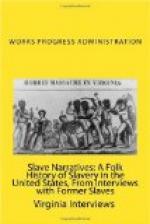The crew wanted me put into irons, but the captain said ’no,—leave him in Liverpool soon as we land—in about a day or two. When I landed there they left me to be deported back to the States according to law.”
“Yes, I had an aunt live to be 112 years old. She died at Granville (Ohio) some thirty years ago. We know her age from a paper on Dr. Cree’s estate where she was listed as a child of twelve, and that had been one hundred years before.”
“About the music now,—you see I’m used to thinking of religion as the working out of life in good deeds, not just a singing-show-off kind.”
Some of the Spirituals are fine, but still I think Wesley hymns are best. I tell my folks that the good Lord isn’t a deaf old gentleman that has to be shouted up to, or amused. I do think we colored people are a little too apt to want to show off in our singing sometimes.”
“I was very small when we went away from Greenbriar County to Point Pleasant, and from there to Gallipolis by wagon. I do remember Mr. Cam. Cree. I was taring around the front lawn where he didn’t want me; he was cross. I remember somebody taking me around the house, and thats all,-all that I can remember of the old Virginia home where my folks had belonged for several generations.”
“I’ve pastored large churches in Louisville and St. Louis. In Ohio I have been at Glendale, and at Oxford,—other places. This old place was for sale on the court house steps one day when I happened to be in Lebanon. Five acres, yes ma’m. There’s the corner stone with 1822—age of the house. My sight is poor, can’t read, so I do not try to preach much anymore, but I help in church in any way that I am needed, keep busy and happy always! I am able to garden and enjoy life every day. Certainly my life has been a fortunate one in my mother’s belonging to Miss Frances Cree. I have been a minister some forty years. I graduated from Wilberforce College.”
This colored minister has a five acre plot of ground and an old brick house located at the corporation line of the village of Lebanon. He is a medium sized man. Talks very fast. A writer could turn in about 40 pages on an interview with him, but he is very much in earnest about his beliefs. He seems to be rather nervous and has very poor sight. His wife is yellow in color, and has a decidedly oriental cast of face. She is as silent, as he is talkative, and from general appearances of her home she is a very neat housekeeper. Neither of them speak in dialect at all. Wade Glenn does not speak in dialect, although he is from North Carolina.
Ex-Slaves
Stark County, District 5
Aug 13, 1937
WILLIAM WILLIAMS, Ex-Slave
Interview with William Williams, 1227 Rex Ave. S.E. Canton, O.
“I was born a slave in Caswell County, North Carolina, April 14, 1857. My mother’s name was Sarah Hunt and her master’s name was Taz Hunt. I did not know who my father was until after the war. When I was about 11 years old I went to work on a farm for Thomas Williams and he told me he was my father. When I was born he was a slave on the plantation next to Hunt’s place and was owned by John Jefferson. Jefferson sold my father after I was born but I do not know his last master’s name.




